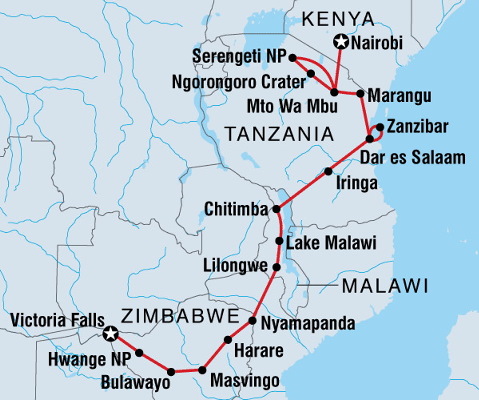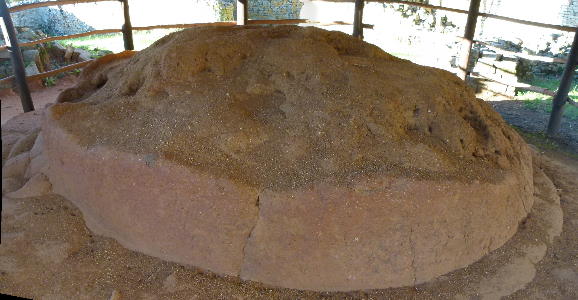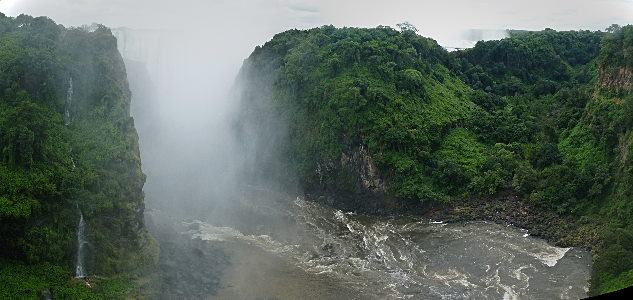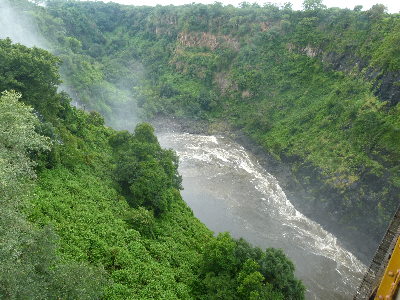
Getting ready to depart for Zanzibar.
Views of the harbor.
Coming into Stonetown we saw the House of Wonders.
Karibu means welcome in Swahili.
We took a tour to Changuu also known as Prison Island.
It never actually served as a prison so the boutique isn't as strange as the prison part of the name.
The tortoises were brought here from the Seychelles and were nearly as big as the ones we saw in the Galapagos Islands.
They are free to wander about just as we were.
That gave us the opportunity to pet them if we wanted to.
They seemed to enjoy it.
Sunset, drinks, and friends, Zanzibar.
A reflection within the lens created an inverted image of the sun on the felucca's sail.
Vendors in Forodhani Park on the waterfront in Stonetown.
Anglican cathedral Christ Church is a Stonetown landmark.
It is on the site of the slave market.
In fact the base of the post where they were tied is visible in front of the altar.
One of the cells where the slaves were kept chained to the floor.
Up to 100 men would have been held in this room.
What do you want? You could probably get it at the market.
The entrance and inside the Old Fort in downtown Stonetown.

On to the spice plantation.
Where we saw banana trees.
Lemon grass
I don't remember what this is so if you can identify it please send me a note.
Star fruit, Averrhoa carambola
Turmeric, Curcuma longa
Soursop, Annona muricata
Mgerenge, Peacock flower tree, Albizana gumifera
Cinnamon, Cinnamomum verum fruit and parasites on a leaf.
A small cinnamon tree.
The fruit of the Achiote Bixa orellana from which annatto is produced.
It is used for color in many foods.
And by the guide who showed us a cacao pod then sliced it in two to show us the "beans" inside
This is what coffee looks like when it is growing.
Because they didn't ripen at the same time each of the "beans" have to be picked individually by hand.
The flower of the Ylang-ylang Cananga odorata tree, used in making perfume.
Black pepper Piper nigrum
Kapok, once used to fill life preservers but now replaced by synthetics.
Cloves prior to drying.
A palm tree climbing demonstration.
The only equipment was a loop of sack material between his feet made from a bag that they use for packing spices.
If you are wondering the tree was about 130 ft (40 meters) tall.
We sampled jackfruit and a fruit whose name I have forgotten that tasted like vanilla pudding.
The King and Queen were supplied with accouterments woven from palm fronds.
The beach where we stayed at Zanzibar

Craft market. Nancy got some ideas for decorating gourds.
Back near camp I found some of young men who showed me that they knew Cat's Cradle.
Masai have always been regarded as fierce warriors so that tribe provides security guards for many businesses on the mainland and here as well.
This guy was the guard at one of our camps.
Note the knife at his waist.
A tiny gecko visited us one night.
Inside the House of Wonders in Stonetown.
A more picturesque part of the Stonetown harbor.
We returned to the mainland and continued our safari.
We saw way too many really big rigs on their sides
More animals along the highway as we drove west.
The markings identify the giraffes as belonging to the Masai subspecies.
And Baobab trees.
A rather prosperous shop at a stop along the road, kids on their way from school, younger ones waving as we pass, a large town we passed through, and setting up camp one evening.
We were treated to a traditional meal of corn, beans, a corn meal paste called umgali, squash and an antelope stew.
Paul and Jodi were our our host and hostess attired in traditional garb.
Most meals were more like this.
We all rotated through the jobs that needed to be done.
Farm fields, rice, and one of the unique landforms we saw.
This is the collection of adapters, power supplies, and wall warts that were needed to keep all the phones, iPods, cameras, and other electronics charged and ready to go.
This is probably a young Angolan Bush Duiker
We stopped in Mzuzu, Malawi for supplies.
We didn't need anything high tech but there were quite a few electrical, phone, and electronic stores here.
We stopped at a roadside charcoal vendor to pick up supplies for a unique cookout later.
Malawi is noted for it's carvers. We picked up more souvenirs.
We were tempted to buy a two piece Malawi chair.... but how can we get everything home?
We made a short stop at a rubber plantation where we saw how they make grooves in the bark where the latex oozes out and is collected in pots.
The last picture is the fruit of the rubber tree.
On the shores of lake Malawi.
That charcoal we picked up was for the party that evening.
A pig was wired to a spit which was supported by sand mats.
We had them along to use under the wheels of our 16 ton truck "Claudia" if we got bogged down in sand or mud.
Roasting took several hours but was well worth it.
Overlanders are those who seek adventure, knowledge, and new experiences.
They are travelers who engage in exciting and adventurous pursuits.
They are that strange breed who chose to travel long distances, over many days, with friends they have just met.
A word of explanation; Kandi Beach Malawi is the site where overlanders have for many years chosen to celebrate their adventure with a party.
Not just any party but a dress up party.
Not just any dress up party but one for which one of your companions has chosen your wardrobe.
We drew names to see whose outfit we would be responsible for that evening and of course we would never know who chose ours.
The vendors in the town were ready with an unbelievable array of fine attire as you will see below.
Nancy had he hair done in many tiny braids which she tied up in two ponytail like bunches.
We got bags with the clothing that others had selected for us.
The then went and donned them and returned to the amusement of all concerned.
Everyone who took part in the fashion show.
Dinner that evening.
While gathered around the campfire we were introduced to one of the local beverages, a interesting concoction called Shake Shake.

It is the absolute worst beverage I have ever consumed.
It tasted like it had been in my stomach which rejected it and I got to "enjoy" it again.
Which very nearly happened.
It is made from sorghum or corn.
It tastes like bacteria and yeast both work on the initial mix so it rots as it ferments.
The process continues even after it is packaged so the cardboard cartons all bulge.
If left too long they would probably explode.
However, it was popular with the local folk.
There is no accounting for taste.
The next day Nancy's braids came out leaving another unique hair style.
Our friend was a totem of good fortune.
A bike repair shop and vegetables for sale along the road and Claudia at a shopping center in Lilongwe.
Malawi is a very poor country but we did see crops raised for export as well as domestic use.
Papaya, tobacco, grain elevators, greenhouses for flowers, and a lumber mill.
A few random shots to give you a sense of the country.
On to Zimbabwe where we visited the Great Zimbabwe.
These stone walls are part of a fortress nearly as old as the pyramids.
They were built without mortar at the top of a hill that overlooked the valley.


The site was well protected. To approach you had to pass through easily defended crevices.
Entry was through a doorway in the wall.
Once inside you could appreciate the skill and care of the builders.
It was built entirely without mortar.
On the valley floor were other structures some more grand than the fortress.

In the largest enclosure was a mound that had been used as the place where girls were introduced to the secrets of women.
Nancy as the matriarch of our group had that duty for the young women in our group.

There was a village near the valley structures.
The folks there entertained us with a dance and encouraged us to join them
Bowls and sculptures were made of clay, fired and then rubbed with graphite.
We supported their endeavor by buying several.
I really liked the symbolism of the shaking hands.
This unusually well appointed camp had fresh grapefruit ready for picking.
Moving on.
The next camp had marula fruit littering the ground.
It has been reported that elephants can get drunk by eating the fermented fruit.
That is probably not true unless elephants have a very low tolerance but it makes for am amusing mental picture.
The ripe fruit is good and the fermented product, available as Amarula, is especially so.
It was hard to believe that some of these rock piles were natural or even possible.
Roads in the Matobo Hills aren't exactly smooth.
This video has the benefit of stabilization in the camera and post processing to reduce the shakes but it still gives you some idea.
People have been painting pictures on the walls of this cave for thousands of years.
Antelope, giraffe, and zebra were most common with a few people scattered about.
The arch in the last picture probably represents the sky.
We had seen similar flattened arches when we were in Egypt.
Those apparently represented a deity with the arch being the body and head, hands, and feet added at the ends.
We stopped at a village where Chief Bondo told us about when he was a young man out hunting and was attacked by a leopard.
He was malled and would not have survived if someone had not come by and taken him, unconscious, to a hospital.
When he came to in a white room with electric lights his first thought was ... "Maybe I died".
He showed us the scars from the attack on his back and legs.
And if you are wondering that is the leopard's skin he is wearing.
He was proud to show the hole where his spear had entered.
He also showed us some paintings in a natural rock shelter near the village.
We had fun with the kids there, dancing, teaching, and learning some new string figures.
Chief Bondo's grandson showed me several figures.
I didn't understand most of his names for them but we had fun anyway.
The first one is called Two Bridge in other parts of Zimbabwe.
The second one he may have called Spear and I have no idea what the third one is.
Here is a simple escape trick he showed me.
Get a loop of string and try to follow, I bet you won't be able to unless you are very observant.
It is quick, he does it twice in 11 seconds.
he isn't hiding any moves, do exactly what he does and it works.
Here is an clip as we were leaving of him showing me that he knew how to do the one that I had taught him.
Take note of the vehicle we used while we went in search of big game, note especially the lack of solid sides.
Also note the sign says no firearms are allowed so we didn't have that option if attacked.
And the roads did not make it easy if a quick getaway was required, we had to clear fallen trees several times.
And if we happened to stumble on poachers or have been mistaken for them we would have certainly not have fared well.
The guide did say it was OK to approach this rhino, just not too close.
His name was Gumboots.
With a name like that it was hard to take him as a serious threat.
His horn is starting to regrow it had been cut off to reduce the chance that poachers would shoot him.
Unfortunately the effort to keep him from being shot by poachers wasn't successful.
He was killed less than one year after we met him.
RIP Gumboots.
A mom and a baby at another location.
Nancy is pointing to the bullet hole in a skull of one who had been killed by poachers.
We stopped to take a picture and the guide got ahead.
We found that it was easy to lose sight of him in the tall grass.
Fortunately I had marked the vehicle's location on my GPS.
You take a moment to relax whenever you can.
Or grab a cool drink.
At another stop our guide spilled a little cola on the rock and these lizards came out to lap it up.
Mother-in-law plant.
If you happen to eat some your throat will swell until you can't talk.
How do you think it got it's name?
Another artist with one of the carvings we bought.
A little of the wildlife in southern Zimbabwe's national parks.
The footprint left no doubt about the animals who had been giving themselves dust baths here.
A night wildlife drive let us see different view.
One of the surprises was when the driver went crashing through the brush toward a tree where a troop of baboons had bedded down.
Suddenly they were raining down all over the place.
I wish I had more than a mental picture for you.
Another shot of our crew.
We made it to the city of Victoria Falls.
One of our stops there was a deck where we could look down at a water hole and enjoy a libation.
Then on to Boma a restaurant specializing in game foods and other African foods and entertainment.
We were outfitted with appropriate robes and some had their faces decorated..
And plied with an array of foods that you have to experience to believe.
In addition to the foods you see below we also sampled zebra, eland, impala, crocodile, and others.
One of the "highlights" of the cuisine was the Mopani worms that were served.
We tried them and have the certificates to prove it.
Some of the entertainers.
Musicians playing Kalimbas (thumb pianos) in gourd resonators.
Drum lesson and game.
We were each given a drum and then this fellow taught us how to play them, then tested us with a game.
A Doo Wop group also provided entertainment.
We bought their CD.
Victoria Falls is where Stanley finally found Livingston.
This tree is where they met.
The falls are more than a mile wide 1,708 m (5,604 ft).
The massive flow crashes into a narrow gorge 108m (360 ft) deep creating spray that has no place to go but back up to where you are, at times entirely blocking the view of the other side.
An impressive sight.
When you visit be aware that you will get very wet.
It was like being in the most intense downpour I have ever experienced and I have exxperienced a hurricane.
The volume varies with the season with the maximum monthly flow being greater than that of Niagara.

Looking at the falls from downstream.

Zambezi river gorge.

The perpetual mist from the falls gives a unique ecological mix.
Below the falls a bridge spans the river.
It is used to get to and from Zambia by heavy truck traffic that passed through town and occasional light pedestrians.
I found a couple of folks who showed me some string figures.
Silvia showed me one she called Two Bridge.
I saw the same figure on the island of Fakarava in the South Pacific where it is called Fishing Net.
She also showed me one she called Four Bridge which has 4 diamonds between the top and bottom strings and resembles the bridge over the Zambezi.
It is nearly the same as one called Jacob's Ladder in Kentucky.
This fellow showed me a another figure.
I didn't get his name or the name of the figure.
We saw these animals while I was wandering on the edge of town.
Local folks told about having elephants come downtown on occasion.
Huge ivory tusks decorated one of the old hotels near the bridge.
A cruses on the Zambezi above the falls gave us the chance to see even more wildlife.
And a beautiful sunset.
